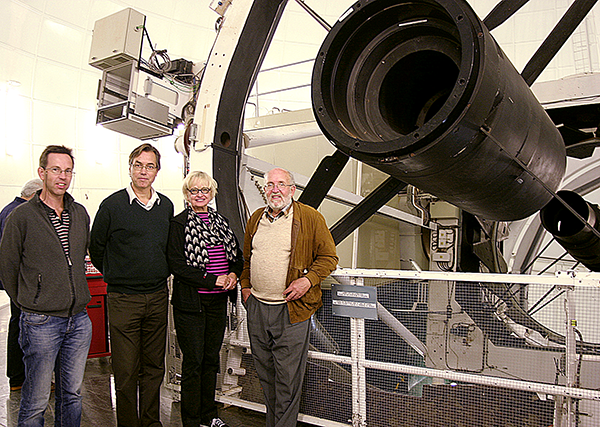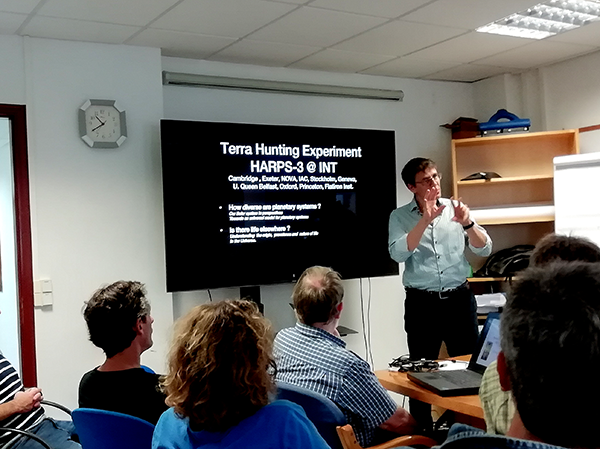ING/IAC news release
9 October, 2019
Didier Queloz, Physics Nobel Prize Winner 2019, Is Developing an Advanced Terrestrial Planet Hunter for the Isaac Newton Telescope
The Isaac Newton Group of Telescopes (ING) and the Institute of Astrophysics of the Canary Islands (IAC) warmly congratulate James Peebles (Princeton University), Michel Mayor (University of Geneva) and Didier Queloz (Universities of Geneva and Cambridge) on the award of the Physics Nobel Prize 2019.
The Swedish Academy awarded the prize "for contributions to our understanding of the evolution of the universe and Earth's place in the cosmos". For Mayor and Queloz, the award recognises their discovery, published in 1995, of the first planet outside the solar system, orbiting a solar-type star. Peebles is recognised for his theoretical contributions to physical cosmology.
|

|
Michel Mayor at the WHT in April 2013.
Credit: ING.
Larger format: PNG.
|
This Nobel Prize Award has special relevance for the ING, which in 2017 signed an agreement with Prof. Queloz for the installation of a powerful new spectrograph at the Isaac Newton Telescope (INT). Queloz and a European / North American consortium that includes the IAC, are building this instrument (HARPS-3), to carry out the Terra Hunting Experiment (THE). The THE survey, covering 10 years of observations, will study the stars closest to the Sun visible from the northern hemisphere, in order to identify and study twin planets of the Earth, orbiting in the habitable zone of stars like the Sun.
|

|
Didier Queloz gives a seminar at the ING offices in Santa Cruz de La Palma in April 2019
on HARPS-3 and the Terra Hunting Experiment.
Credit: ING.
Larger format: PNG.
|
Marc Balcells, Director of the ING telescopes, stressed that "the discovery of the first extra-solar planet orbiting a solar-type star marked a milestone in modern astronomy, opening a field of research that has expanded enormously in recent years and which allows humanity to advance its search for life outside our planet. For the ING, collaboration with Queloz represents a tremendous opportunity to continue decades of contributions to astronomy, and shows that medium-size telescopes such as the INT can be competitive when they are equipped with cutting-edge instrumentation."
Jonay González Hernández, Ramón y Cajal researcher at IAC and Spanish Principal Investigator of HARPS-3, explains that "IAC is developing one of the HARPS-3 subsystems. This instrument will allow the velocities of stars to be measured with accuracy better than 1 meter per second."
The IAC has also collaborated with Mayor in the construction of the ESPRESSO instrument for the Very Large Telescope of the European Southern Observatory (ESO), and with Queloz in the SPECULOOS Norte project of the Teide Observatory, Tenerife, for the observation of transits of terrestrial exoplanets in low-temperature stars and brown dwarfs. Mayor has also been a member of the Research Advisory Board of the IAC for several years.
The Nobel Prize in Physics 2019 is the sixth since 2000 that has been awarded for achievements in astrophysics, and the second in the field of observational optical astronomy (the first was in 2011 for the discovery of the accelerated expansion of the Universe).
More information:
"The Nobel Prize in Physics 2019", KVA press release, 8 October 2019.
"Nobel Prize in Physics awarded to Michel Mayor and Didier Queloz", UNIGE press release, 8 October 2019.
The Terra Hunting Experiment.
Talk and photos by Didier Queloz, West Road Concert Hall, University of Cambridge, 9th October 2019.
Didier Queloz, Premio Nóbel de Física 2019, Desarrolla un Avanzado Cazador de Planetas Terrestres en el Telescopio Isaac Newton
El Grupo de Telescopios Isaac Newton (ING) y el Instituto de Astrofísica de Canarias (IAC) se alegran de hacerse eco de la concesión del Premio Nóbel de Física 2019 a los astrónomos James Peebles (Universidad de Princeton), Michel Mayor (Universidad de Ginebra) y Didier Queloz (Universidad de Ginebra y Universidad de Cambridge).
La Academia Sueca otorga el Premio por "las contribuciones a la comprensión de la evolución del universo y del luga r del la Tierra en el cosmos". Para Mayor y Queloz, el premio reconoce su descubrimiento, publicado en 1995, del primer planeta fuera del sistema solar, orbitando una estrella de tipo solar. A Peebles se le reconocen sus aportaciones teóricas sobre cosmología física.
|

|
Michel Mayor en el WHT en abril de 2013.
Crédito: ING.
Formato grande: PNG.
|
La concesión del Nóbel de Física 2019 tiene especial relevancia para el ING, que en 2017 cerró un acuerdo con el Prof. Queloz para la instalación de un potente espectrógrafo en el telescopio Isaac Newton (INT) del Observatorio del Roque de Los Muchachos, La Palma. Queloz y un consorcio europeo y norteamericano que incluye al IAC, construyen este instrumento, de nombre HARPS-3, para llevar a cabo el programa Terra Hunting Experiment (THE) o Cazador de Planetas Terrestres.
|

|
Didier Queloz durante un seminario impartido en las oficinas del ING en Santa Cruz de La Palma en abril de 2019 sobre la ciencia que HARPS-3 y el programa THE tienen previsto desarrollar.
Crédito: ING. Formato mayor: PNG.
|
Marc Balcells, Director de los telescopios ING, resaltó que "el descubrimiento del primer planeta extra-solar marcó un hito en la astronomía moderna, abriendo un campo de investigación que ha crecido enormemente hasta hoy y que permite a la humanidad avanzar en la búsqueda de vida fuera de nuestro planeta. Para el ING la colaboración con Queloz representa una tremenda oportunidad de continuar décadas de aportaciones a la astronomía, y muestra que los telescopios de apertura intermedia como el INT pueden ser competitivos cuando se les dota de instrumentación puntera".
Jonay González Hernández, investigador Ramón y Cajal del IAC e Investigador Principal español de HARPS-3, explica que "en el IAC se desarrolla uno de los subsistemas de HARPS-3. Este instrumento permitirá mediciones de velocidad de las estrellas con una precisión mejor que 1 metro por segundo. El programa THE, que cubrirá 10 años de observaciones, estudiará las estrellas más cercanas al Sol visibles desde el hemisferio norte, con el fin de identificar y estudiar planetas gemelos de la Tierra, orbitando en la zona de habitabilidad de estrellas de tipo solar".
El IAC ha colaborado también con Mayor en la construcción del instrumento ESPRESSO para el Very Large Telescope del Observatorio Europeo Austral (ESO) y con Queloz en el proyecto SPECULOOS Norte del Observatorio del Teide, Tenerife, para la observación de tránsitos de exoplanetas terrestres en estrellas muy frías y enanas marrones, junto con Rebolo y Roi Alonso. Mayor ha sido, además, miembro del Consejo Asesor de Investigación del IAC durante varios años.
El Premio Nóbel de Física 2019 es el sexto que se otorga a resultados de la astrofísica desde 2000, y el segundo en su historia en el campo de la astronomía óptica observacional (el primero en 2011 por el descubrimiento de la expansión acelerada del Universo).
Más información:
"The Nobel Prize in Physics 2019", Nota de Prensa de KVA, 8 de octubre de 2019.
"Nobel Prize in Physics awarded to Michel Mayor and Didier Queloz", Nota de Prensa de UNIGE, 8 de octubre de 2019.
The Terra Hunting Experiment.
Charla y fotos de Didier Queloz, West Road Concert Hall, University of Cambridge, 9 de octubre de 2019.
|
|
|



